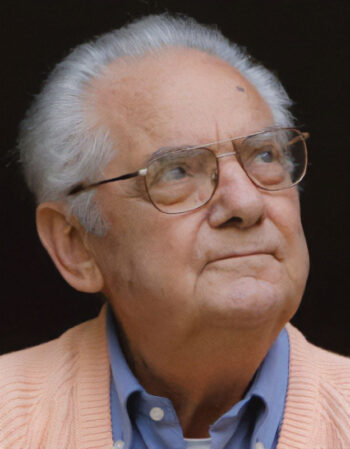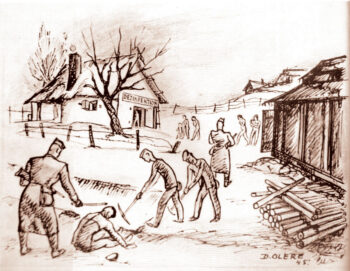Venezia, Shlomo

Shlomo Venezia (29 Dec. 1923 – 1 Oct. 2012) was an Italian Jew deported from Greece to Auschwitz, where he arrived on 11 April 1944 together with his brother Morris Venezia and five other notorious false witnesses: Josef Sackar, Yaakov Gabai, Shaul Chasan, Leon Cohen and Daniel Bennahmias. After three weeks of quarantine, Venezia was supposedly assigned to the so-called Sonderkommando of Birkenau Crematorium III (but also to that of Crematorium II and briefly to that of Bunker 2…).
After 50 years of contaminating his memories with ubiquitous mainstream Holocaust themes and tropes, he finally decided to make public statements about his alleged experiences by granting an interview in 1995. Six years later, he made a written deposition, followed by another interview in January 2002. Five years after that, he had his own book published that expanded on the theme even more. And last but not least, a hitherto-unpublished statement of his appeared in 2010.
Here are some of the peculiar claims Venezia made in his various statements, some of which were “aided” by mainstream historian Marcello Pezzetti, which probably means that they were brought in line with the orthodox narrative:
- He claimed that he and some 320 other inmates were selected on arrival. He can neither have counted this nor remembered it for so long – Venezia’s cousin Yaakov Gabai “remembered” 700 selectees, And indeed, the number “accidentally” matches that printed in the orthodoxy’s standard chronology of the camp (Czech 1990, p. 609).
- He claimed that bodies of deceased inmates were brought to a morgue in Birkenau’s quarantine sector, where they were allegedly left to rot for two or three weeks. However, there was no morgue in that camp sector, and several documents show that corpses were picked up twice a day throughout the camp and brought to the crematoria’s morgues. In fact, Venezia uses the official German term for the basement morgues of Crematoria II and III – Leichenkeller. However, these supposedly served as undressing rooms and gas chambers. But if corpses were brought there for storage, then which rooms served the extermination purposes?
-

Auschwitz-Birkenau, 26 May 1944: inmates deported from Hungary walking from the train westbound along the railway ramp, passing between Crematoria II and III. Crematorium III is visible in the background – with no obstruction by a palisade or anything similar. Photo taken from The Auschwitz Album (Meier/Klarsfeld 1989). When he claimed to have started working at Crematorium III, a “palisade three meters high” allegedly surrounded the building. However, a photo from the so-called Auschwitz Album, taken on 26 May 1944 by SS men on occasion of the arrival of a train with Jews deported from Hungary (hence a little later than Venezia’s first day at work – this photo is reproduced in Venezia’s book) shows that this building had no palisade around it at all. However, Filip Müller mentioned this palisade in his account, which may be Venezia’s source.
- According to his book, when weeding the yard of Crematorium II on his first day of work, Venezia noticed “a window” on eye level, peeked through it, and saw corpses piled up. However, this building had 47 windows on eye level.
- In his 2002 interview, however, he claimed that, on the first day of work, he was granted the privilege to work at the so-called “Bunker 2” for just one day, so he could witness a gassing and tell the world about it later. However, the orthodoxy insists that Bunker 2 was re-activated only with the arrival of transports from Hungary starting on 17 May 1944, hence several weeks after Venezia’s alleged first day at work.
-

“Bunker 2.” Drawn by David Olère in 1945, showing just one door and one window/hatch. (Klarsfeld 1989, p. 34) To accomplish the gassing, an SS man dropped a box of “stuff” through a hatch, and ten minutes later, “the door” (singular) was opened. However, the mainstream narrative has it that pellets from a can of stuff (Zyklon B) were poured through five hatches, and four doors were opened afterwards. Incidentally, Venezia’s wrong description matches a similarly flawed drawing by David Olère, which is reproduced in Venezia’s book – another case of cross-pollination into the “convergence of evidence” on a lie.
- The imaginary gassing at Bunker 2 lasted only ten minutes. However, ten minutes is too short to kill people with Zyklon B without any means to accelerate the evaporation of the liquid poison from the carrier material and the dissipation into a large room.
- After the gassing, the doors were opened, and Venezia and his colleagues had to drag out the corpses right away. However, entering a room for heavy labor in which Zyklon B granules, poured among the victims, was still releasing its poison, would have been fatal in the long run without gas masks and protective clothes. Airing out such a place for many hours if not days would have been mandatory.
- The gassing victims’ bodies were thrown onto a huge burning pit. However, with such a blaze causing severe burns to anyone approaching it, they must have used catapults to sling the corpses into the blazing pit from a safe distance.
- Corpses in open-air incineration pits burned all by themselves due to their body fat, which Venezia and his colleagues had to collect and pour back onto the burning pyre. However, the self-immolation of human bodies is a myth, and no fat from burning corpses can accumulate anywhere, let alone be collected, as it burns the instant it reaches a corpse’s surface.
- The very few things Venezia says about Crematoria II and III are wrong: During a gassing, he and a colleague helped an SS man pour Zyklon B into “a manhole” on the morgue’s roof. Therefore, Venezia helped mass-murder his fellow Jews! This runs contrary to the orthodox narrative, which has exclusively SS men doing that job, and there were supposedly four Zyklon-B introduction devices, not one manhole, through which the poison was allegedly poured. In reality, however, there weren’t any openings in that roof at all.
- There were allegedly fake showerheads on the ceiling of the gas chamber. However, documents clearly show that these showers were real functioning showers.
- The gas-chamber door presumably looked like that of a walk-in fridge. However, all doors at Birkenau were made of wooden boards held together by iron bands and were manufactured by inmates in the camp’s carpentry shop. Venezia may have taken that false description from another drawing by David Olère.
- Venezia insisted that SS men never wore any gas masks at the crematorium – that’s because there never was any gas…
- He mentioned Josef Mengele’s “Hungarian-Jewish physician assistant,” which is a clear reference to Miklós Nyiszli. This indicates that Venezia was aware of, and influenced by, Nyiszli’s book about Auschwitz.
- Like Miklós Nyiszli and his plagiarizer Filip Müller, Venezia insisted that the gas was “thrown on the ground” of the gas chamber, which was occupied by up to 1,700 people. The evaporating gas filled the chamber like water – from the bottom to the top. Consequently, the victims, in an attempt to reach higher layers with non-poisonous air, climbed “on top of each other until even the last one died.” However, the active ingredient of Zyklon B, hydrogen cyanide, is insignificantly lighter than air and invisible. Hence, no such scene would have occurred. This proves that Venezia has never seen a real homicidal gassing with Zyklon B, and that he has plagiarized this scene either from Nyiszli and/or from Müller. In addition, the orthodoxy claims that Zyklon B wasn’t thrown on the ground, but rather that it was retrievable via certain Zyklon-B introduction devices after the alleged murder.
- When it comes to how corpses were dragged out of the gas chamber and to the furnaces, Venezia expressly refers to two drawings by David Olère as printed in his book. Other scenes Venezia describes are also evidently inspired by Olère’s drawings printed in his book.
- Inspired by Nyiszli’s invented story of a young woman who came out of the gas chamber alive, Venezia invented a similar scene. In his tale, the sole gassing survivor was a breast-feeding baby, allegedly kept alive “by the force of the suction at her mother’s breast” – which is pure nonsense.
- Two to three bodies were cremated in each muffle at once within 20 minutes. However, the cremation of one body took roughly an hour. Furthermore, had they managed to stuff three corpses into a muffle designed only for one body, it would have taken three times as long if not longer to cremate them. Hence, Venezia exaggerated the cremation capacity by a factor of nine. The same technically impossible data was mentioned by Nyiszli: three bodies per muffle within 20 minutes. However, Venezia contradicted himself on this topic numerous times.
- Venezia personally saw flames escaping from the crematorium chimneys, although such a phenomenon is technically impossible with coke-fired crematoria.
As can be seen, Venezia included almost all the false rumors and clichés about the extermination activities claimed for Auschwitz in order to beef up his story, including the untrue claim, evidently also copied from Nyiszli, that the members of the Sonderkommando were killed every four months to eliminate dangerous carriers of secrets – except for Venezia and his brother, of course.
Venezia’s late narrative has gained much attention worldwide. His book has been translated into 23 languages, including Arabic, Farsi (Persian) and Marathi (a language spoken in India). It has been hailed by the orthodoxy as the latest and one of most convincing stories yet about the gas chambers at Auschwitz, although it is mostly a regurgitation of invented themes spread by David Olère, Miklós Nyiszli and Filip Müller.
(For more details, see Mattogno 2010a; 2022e, pp. 101-131.)

You need to be a registered user, logged into your account, and your comment must comply with our Acceptable Use Policy, for your comment to get published. (Click here to log in or register.)